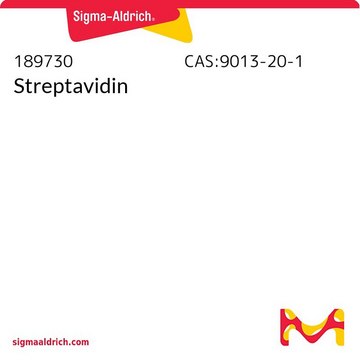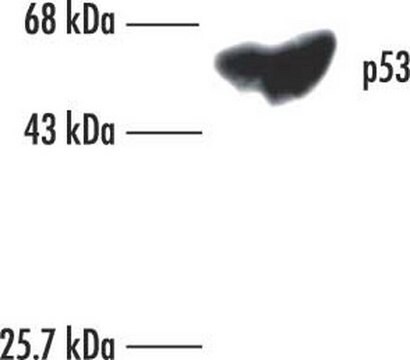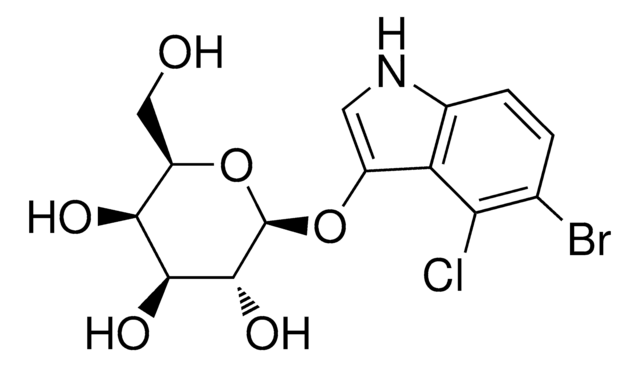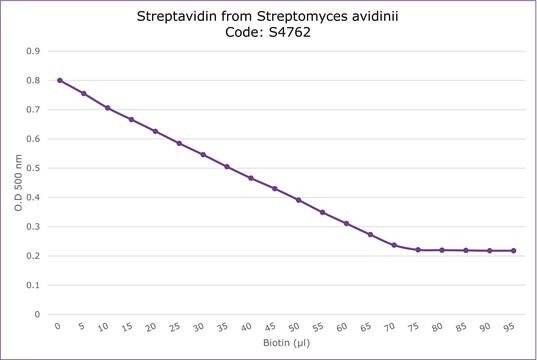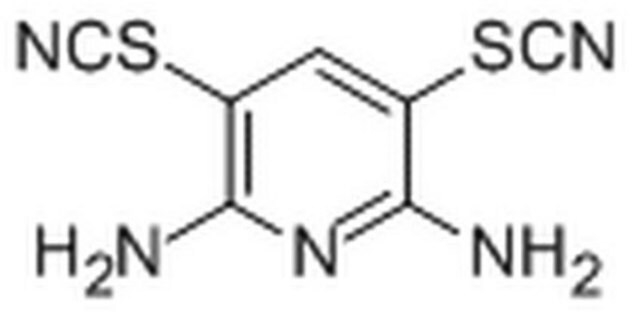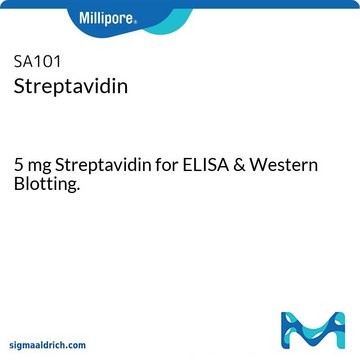推薦產品
生物源
mouse
品質等級
抗體表格
purified antibody
抗體產品種類
primary antibodies
無性繁殖
DO-1, monoclonal
形狀
lyophilized
不包含
preservative
物種活性
feline, human
應無反應活性
mouse, rat
製造商/商標名
Calbiochem®
儲存條件
OK to freeze
同型
IgG2a
運輸包裝
ambient
儲存溫度
2-8°C
目標翻譯後修改
unmodified
基因資訊
human ... TP53(7157)
一般說明
Purified mouse monoclonal antibody generated by immunizing BALB/c mice with the specified immunogen and fusing splenocytes with X63Ag8.653 mouse myeloma cells (see application references). Recognizes the ~53 kDa mutant and wild-type forms of p53.
Recognizes the ~53 kDa wild-type and mutant p53 protein in A431 cells and breast carcinoma tissue.
This Anti-p53 (Ab-6) (Pantropic) Mouse mAb (DO-1) is validated for use in Frozen sections, Gel Shift, Immunoblotting, ICC, IP, Paraffin sections for the detection of p53 (Ab-6) (Pantropic).
免疫原
Epitope: Within amino acids 21-25 of human p53
Human
wild type, recombinant, human p53
應用
Frozen sections (1 µg/ml; see application references)
Gel Shift (see comments)
Immunoblotting (0.1 µg/ml; see application references)
Immunocytochemistry (1-2.5 µg/ml; see application references)
Immunoprecipitation (1 µg/ml or use Cat. No. OP43A; see application references)
Paraffin sections (1 µg/ml, pepsin, heat or pressure cooker pre-treatment required; see application references)
Gel Shift (see comments)
Immunoblotting (0.1 µg/ml; see application references)
Immunocytochemistry (1-2.5 µg/ml; see application references)
Immunoprecipitation (1 µg/ml or use Cat. No. OP43A; see application references)
Paraffin sections (1 µg/ml, pepsin, heat or pressure cooker pre-treatment required; see application references)
警告
Toxicity: Standard Handling (A)
外觀
Lyophilized from a volatile buffer, 100 µg BSA.
重構
We recommend resuspending the lyophilized antibody with sterile phosphate buffered saline (PBS), pH 7.4, or sterile 20 mM Tris-saline (20 mM Tris containing 0.15 M NaCl), pH 7.4, to yield a final concentration of 100 μg/ml. Reconstituted product will be more stable if 0.1% sodium azide is added (do not add azide if antibody is to be used with viable cells). Lyophilized antibodies should be resuspended at 4°C with occasional gentle mixing for at least two hours. Following reconstitution, refrigerate (4°C) for short-term storage or aliquot and freeze (-20°C) for long-term storage.
分析報告
Negative Control
SK-OV-3 cells or normal skin tissue
SK-OV-3 cells or normal skin tissue
Positive Control
A431 cells or breast carcinoma tissue
A431 cells or breast carcinoma tissue
其他說明
El-Deiry, W.S., et al. 1994. Cancer Res.54, 1169.
Greenblatt, M.S., et al. 1994. Cancer Res.54, 4855.
Legros, Y., et al. 1994. Oncogene9, 2071.
Barak, Y., et al. 1993. EMBO J.12, 461.
Kastan, M.B., et al. 1992. Cell71, 587.
Kuerbitz, S.J. 1992. Proc. Natl. Acad. Sci. USA89, 7491.
Lane, D.P. 1992. Nature358, 15.
Vojtesek, B., et al. 1992. J. Immunol. Meth.151, 237.
Kastan, M.B., et al. 1991 Cancer Res.51, 6304.
Greenblatt, M.S., et al. 1994. Cancer Res.54, 4855.
Legros, Y., et al. 1994. Oncogene9, 2071.
Barak, Y., et al. 1993. EMBO J.12, 461.
Kastan, M.B., et al. 1992. Cell71, 587.
Kuerbitz, S.J. 1992. Proc. Natl. Acad. Sci. USA89, 7491.
Lane, D.P. 1992. Nature358, 15.
Vojtesek, B., et al. 1992. J. Immunol. Meth.151, 237.
Kastan, M.B., et al. 1991 Cancer Res.51, 6304.
Recognizes both mutant and wild-type p53 under denaturing and non-denaturing conditions. This antibody reacts weakly with rodent p53; we do not recommend it for rodent samples. For gel shift assay, resuspend in 100 µl of buffer. Wild-type p53 has a short half life and is present in low amounts in cells. For immunoprecipitation increasing the amount of sample and labeling with 35S-Met for less than or equal to 1 h will aid in visualizing wild-type p53. Antibody should be titrated for optimal results in individual systems.
法律資訊
CALBIOCHEM is a registered trademark of Merck KGaA, Darmstadt, Germany
未找到適合的產品?
試用我們的產品選擇工具.
儲存類別代碼
11 - Combustible Solids
水污染物質分類(WGK)
WGK 1
分析證明 (COA)
輸入產品批次/批號來搜索 分析證明 (COA)。在產品’s標籤上找到批次和批號,寫有 ‘Lot’或‘Batch’.。
Darren M Hutt et al.
Methods in molecular biology (Clifton, N.J.), 1510, 77-91 (2016-10-21)
Gene expression is regulated in part through the reversible acetylation of histones, by the action of histone acetyltransferases (HAT) and histone deacetylases (HDAC). HAT activity results in the addition of acetyl groups on the lysine residues of histone tails leading
E E Hoskins et al.
Oncogene, 27(35), 4798-4808 (2008-04-29)
Fanconi anemia (FA) is a genome instability syndrome that is characterized by progressive bone marrow failure and a high risk of cancer. FA patients are particularly susceptible to leukemia as well as squamous cell carcinomas (SCCs) of the head and
Yan Degenhardt et al.
Molecular cancer therapeutics, 9(7), 2079-2089 (2010-06-24)
Polo-like kinases are a family of serine threonine kinases that are critical regulators of cell cycle progression and DNA damage response. Predictive biomarkers for the Plk1-selective inhibitor GSK461364A were identified by comparing the genomics and genetics of a panel of
H Takahashi et al.
Oncogene, 36(30), 4267-4276 (2017-03-28)
L-asparaginase has been used for more than three decades in acute lymphoblastic leukemia (ALL) patients and remains an essential drug in the treatment of ALL. Poor response to L-asparaginase is associated with increased risk of therapeutic failure in ALL. However
Kristina Heyne et al.
Cell cycle (Georgetown, Tex.), 12(15), 2479-2492 (2013-07-11)
The inflammation regulating transcription factor NFκB and the tumor-suppressing transcription factor p53 can act as functional antagonists. Chronic inflammation (NFκB activity) may contribute to the development of cancer through the inhibition of p53 function, while, conversely, p53 activity may dampen
我們的科學家團隊在所有研究領域都有豐富的經驗,包括生命科學、材料科學、化學合成、色譜、分析等.
聯絡技術服務
